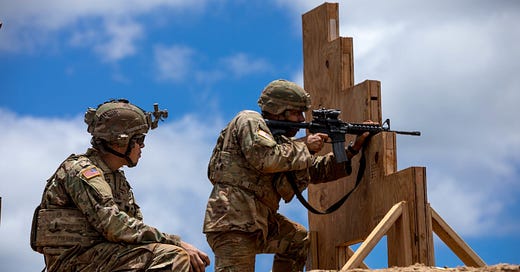Integrated Weapons Training Strategy: U.S. Army Qualification
"The Army qual is cool. It would be a lot cooler if we could do ANY shooting between annual qualifications."
“The current Army qualifcation is cool. Shooting around barricades and reloading during a continuous course is more realistic than the previous qual. It would be a lot cooler if we could do ANY shooting between annual qualifications.”
The current U.S. Army Integrated Weapons Training Strategy and qualifications are more realistic courses and the Training Circulars that describe them are great improvements to doctrine pushing for better and more relevant training. That is unarguable.
However, that doesn’t mean it’s a better program for the entire Army. For anyone who thinks that “more realistic” is automatically better, I remind you that a true Two Way Range with someone shooting back with live ammunition during the qual would be more realistic.
The new qualification is a better basic marksmanship test for soldiers, however, a qualification is not training; it is a test, a certification. The problem is the only time most units, even Infantry and combat arms units in Brigade Combat Teams, ever do any live fire is when they go to qualify. There are no ranges where soldiers just go to learn or practice, and in most cases, they only ever handle weapons during qualification or field exercises where marksmanship is not practiced. Just as bad, despite having high-level shooting programs such as the Army Marksmanship Unit and Army Reserve Marksmanship Unit along with formal courses like the Marksmanship Master Trainer Course, most qualifications are conducted by local personnel who have never been vetted to determine if they’re aware of what the current standard is, much less if they’ve read and understand it.
No, this is not unique to the Army:
The new qual has really opened eyes to how poorly most soldiers handle their weapons. Unfortunately, it doesn’t seem to have done the same for leadership:
In many ways, the new qualification tables are emblematic of our failings as an Army. We are not properly training soldiers at the lowest level. Rather than address the root causes of that problem (high OPTEMPO, overtasked formations, disempowered junior leaders, risk-avoidant commanders, limited range access, etc) the Army leadership has heavy-handedly slapped on a higher standard to raise the bar without addressing time and resources to help personnel rise to that standard.
This is Task Force Smith repeated endlessly (click to read).
The standard of training is not actually being raised, it just means that more people are qualifying on their second or third attempt rather than their first. They’ll pass their qual…. eventually, and then be marked in DTMS as fully qualified. Note, a “qualified” soldier is never indicated if their passing score was done on the first, second, third (more?) attempt. That might make an “expert” badge more exclusive (as long as everyone remains honest), but our leaders seem to have forgotten that the Army isn’t here exclusively to produce SF operators. There is such a thing as good enough, we don’t need everyone to be outstanding. However, whatever “good enough” is supposed to be must be enforced rather than pencil-whipped as an accounting fiction.
In the meantime, the failure of senior leaders to perform DOTMLPF-P analysis and implement change to standard is evident. Alt-C was very much an easy button. It was the easy button because everything could be done on one of many 25-meter ranges rather than competing for Automated Record Fire ranges. Despite that requirement, more ARF “pop up” ranges have not been built.
The mandate to use the EST as part of the IWTS progression doesn’t mesh well with the new tables that handicap the EST. The barrier prevents lanes from being used in close proximity, so what was once a ten-lane EST can now fit four soldiers simultaneously, reducing throughput to the point that the requirement is not feasible. Worse, inexpensive simulators (LMTS is one) that every unit could always have in their immediate possession for their sole use continue to be ignored.
The requirement for a full IWTS progression prior to every qualification is absurd. Skills degrade, but rarely to the point that they never existed. What’s worse is that the overall impact to training calendars was never analyzed, so the list of things that companies are supposed to accomplish in a year just got even longer during that same timeline. Even if there is time, repeating the full IWTS is rehashing the same lessons and never progressing, rather like repeating first grade for your entire career.
In many ways, comparison to the ACFT is good. They are both heavy-handed attempts by HQDA to “raise the standard” that fail to account for varying needs across the Army, don’t allow for subordinate commanders to determine training needs, and were not properly planned or resourced according to published doctrine. The difference is that, with the ACFT and its price tag ($110 million+ and growing) at least soldiers got increased access to weight sets and new gym equipment at the unit level. Despite the IWTS requirements, nobody is getting more ammo and range time and EST time to train on weapons.
The weapons quals and the ACFT are both good tests completely on their own, but the ability to properly implement and prepare for them was never provided for. It’s a great example of typical Army fuckery where decision makers at the top fail to consult with those at the bottom of the pyramid to hear about all of the intricate details that they did not account for.






